How to Implement Account-Based Marketing Into Your Strategy to Get the Most Benefits It Can Grant
1. What are the essential differences between account-based marketing and inbound marketing?
2. Three types of account-based marketing
3. The key principles of an account-based marketing strategy
4. How to utilize ABM in the existing marketing campaign to increase your brand awareness and ROI
5. Which are the essential pros and cons you should pay attention to in ABM?
6. The best working account-based marketing examples you can use
Useful tools:
1. Newoldstamp - Email signature marketing
2. SendGrid - Email builder and sender
3. Boomerang - Tool for scheduling emails
4. Mailtrack - Email link opens tracking
5. Canva - Online tool for making designs
“We brought the leads, why didn’t they become customers?”- marketers complain. “You brought us the wrong leads!” - sales managers answer. This is a common situation in the B2B world.
In B2B markets, where the cost of transactions is high, and the sales cycle is long, companies are striving to minimize the cost of attracting customers. Therefore, since the beginning of the 2000s, a new approach has been gaining popularity that has eliminated the long-standing conflict between sales and marketing and joined their forces to nurture customers who bring much of the company's revenue. The approach is called account-based marketing (ABM).
What are the essential differences between account-based marketing and inbound marketing?
Explaining the difference between ABM and traditional inbound marketing, we want to use a nice metaphor: using traditional lead generation, you fish for small fish with a net; using ABM, you fish with a pole for sharks.
Now let's explore the main characteristics of ABM that distinguish it from inbound marketing.
-
A strategy designed to interact with the most relevant accounts
In ABM, you build your strategy according to certain accounts that you find the most relevant for your needs, while inbound marketing focuses on generating leads and converting them into clients.
-
Personalization is the key in ABM
Personalization is absolutely essential for engaging accounts. It helps create meaningful content, establish deep relationships, and increase conversion rates and revenue.
-
Sales and marketing teams work as close as possible
Companies that align their sales and marketing teams can enhance brand awareness and achieve larger deal size. As a rule, marketers work on creating marketing campaigns to attract new potential customers. Then sales reps only need to find some leads that might actually buy. With account-based marketing, the goal is to close a single account, which means both teams concentrate on the same business goal. In ABM, salespeople identify the pains and needs of each customer. Marketers build a strategy according to personalized data from the sales teams.
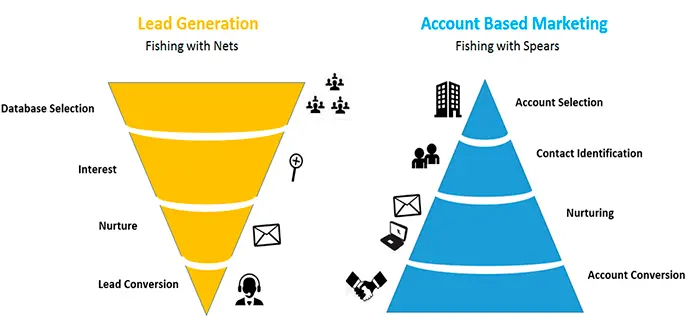
source: neilpatel
Three types of account-based marketing
B2B companies segment customers according to various criteria: countries and regions, market segments, loyalty levels, etc. When it comes to ABM, most B2B companies distinguish three types of ABM:
-
Strategic
With a strategic type (also called 1:1 ABM), ABM teams focus on one to ten accounts at a time. It is used for the most significant customers with a large check (or annual contract amount).
-
Lite
ABM Lite (also called a one-to-few approach) is when the team is focused on a wider group of strategic accounts (usually from 10 to 100) with similar issues and needs. This approach is suitable for enterprise or mid-market accounts.
-
Programmatic
Programmatic type (also called the one-to-many approach) involves targeting lists of 100 to 1000 accounts. This approach is possible thanks to the modern technologies that enable accurate targeting, analytics, and personalization across hundreds and even thousands of identified accounts.
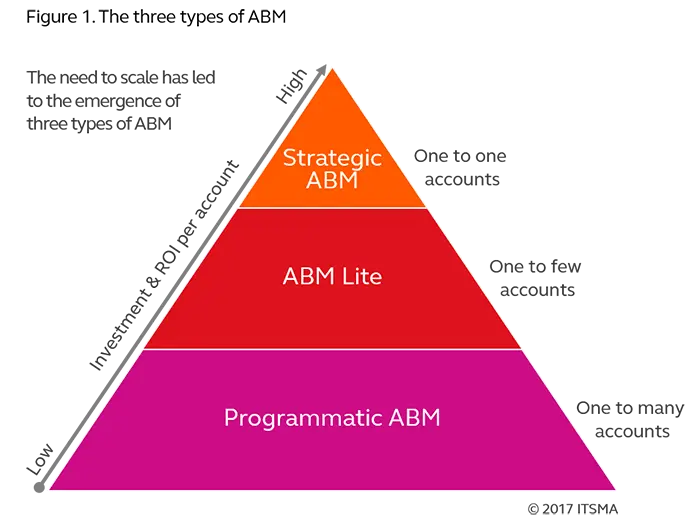
source: itsma
The key principles of an account-based marketing strategy
If you are considering ABM, here are the key account-based marketing tactics to craft your strategy around.
-
Finding the decision-makers in each company and identifying them as a relevant audience
The point of account-based marketing is to focus the team’s resources on the highest-value prospects. For example, a company trying to sell email signature management software would want to identify the key decision-makers in the target organization that would be impacted by the solution. In this scenario, a list of individuals might include CMO, VP of Marketing, and Marketing Manager.
-
Making the sales cycle work faster
For most companies, eliminating unqualified prospects early in the game results in increasing conversions and shortening close times.
-
Using customer loyalty as the key metric
When it comes to ABM, customer loyalty is practically its own form of currency. Loyal customers are likely to refer you to their contacts, continue buying from you as long as the need is there, not open to sales pitches from your competitors, and open to other products/services that you offer.
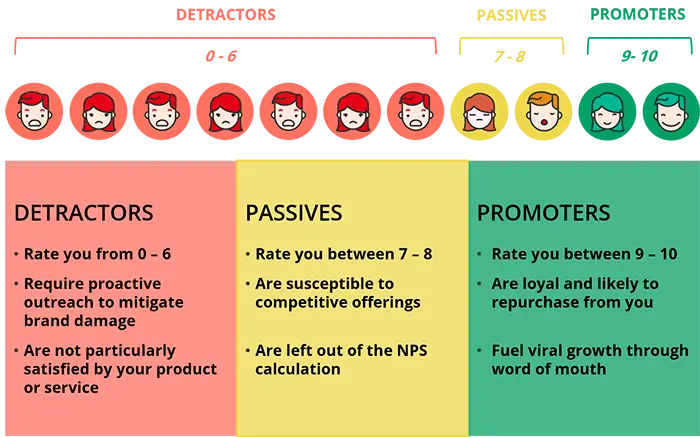
source: netigate
-
Focusing on closing big deals
As we mentioned earlier, ABM is about big deals. In the beginning, the ABM team identifies the biggest opportunities and then proactively goes after them.
-
Caring about the existing users the most
Numerous studies prove that it is much easier for organizations to generate more sales from existing clients than from the new ones. Also, with the help of your current customers, you can create real advocates who become an authentic voice for promoting your product or service.
You might also like this article: “10 Reasons to Consider Email Signature as Additional Marketing Channel.”
How to utilize ABM in the existing marketing campaign to increase your brand awareness and ROI
There are eight important stages that will help you get started with account-based marketing.
Stage 1: Building the highest-value account profiles
Analyze your existing customer base to identify those profiles that match your ideal customer definition. Although this definition may vary depending on various nuances (for example, the industry they are in), it often comes down to the most profitable, long-term, and satisfied clients. Working with them is always an enjoyable experience. For new accounts, you should answer the question “Does this account have an urgent need that we can meet and that would make them spend $X?”
Important points worth exploring:
-
The essential attributes of an ideal account
They are a good fit for your company; they deliver the highest value; they enjoy your product or service.
-
How are ABM accounts different from buyer personas
They are more precise and aimed at finding individuals, not groups of people.
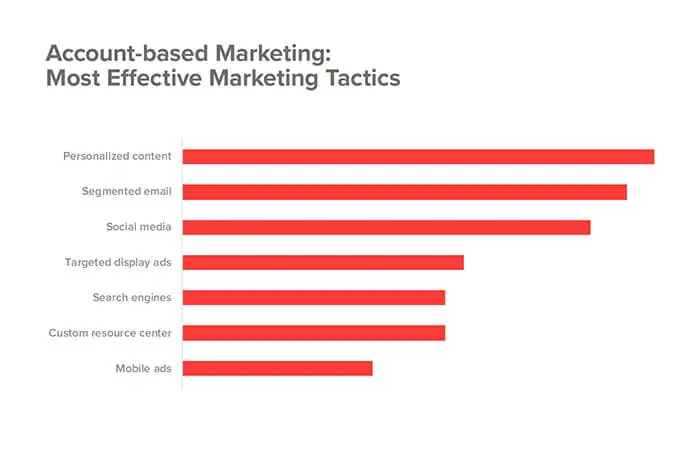
source: superoffice
Stage 2: Finding real individuals who correlate with chosen profiles the most
The next step focuses on the three main aspects:
-
Choosing the roles you will address
Identify those individuals who can influence the final buying decision. Imagine you are selling marketing software. Which people in the target company can be potential decision-makers? Most likely, those people are a Chief Marketing Officer, Chief Information Officer, Chief Financial Officer, and Digital Marketing Managers.
-
Identifying the pains and needs of certain individuals
Form a comprehensive picture of their needs and pain points, as well as where they are in their buyer journey.
-
Matching accounts' needs with your company's strategic goals
After identifying the needs of chosen accounts, you should make sure your company's services are aimed at fulfilling them. So that not to waste resources on irrelevant accounts.
Stage 3: Creating the definition of an optimal targeting campaign
Once you’ve created a list of influencers, start working on your definition of an optimal targeting campaign.
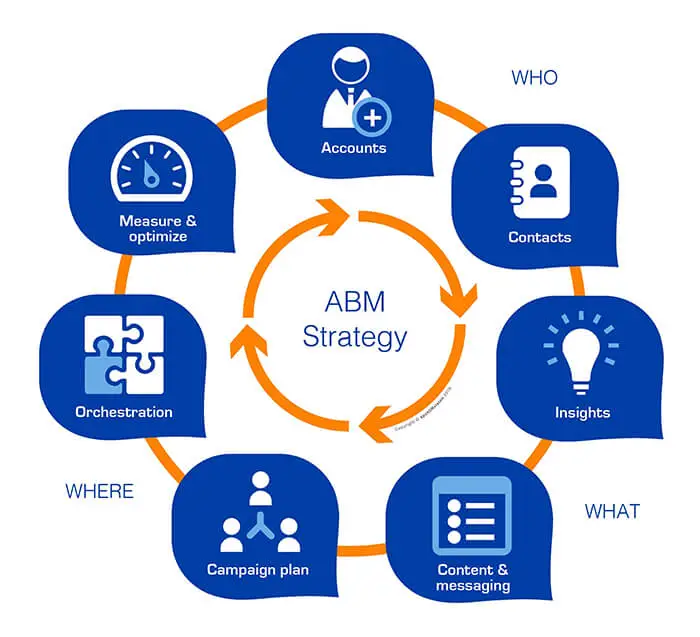
source: spotonvision
-
Put yourself in your prospect's shoes
Efficient strategies start by putting yourself in your prospects shoes. Instead of promoting the high-level benefits of your product or service, think about how this specific customer can experience the most value in their role.
-
Find answers on how to help future customers
Try to find answers to the following questions: What are our customer’s pains and aspirations? How can we deliver unique value to them? What would help our customer ignite change in their company?
-
Define the main stages of a targeting campaign
There might be the following stages: Research and strategy (the campaign start/end date, budget, goals, etc.); Execution (activities); Post-launch (tracking and reevaluation).
Stage 4: Building your marketing campaigns
At this stage, you need to develop personalized campaigns designed to resonate with your target account.
-
Separate the most important accounts
ABM requires a special approach to every kind of account, which might take a lot of time and effort. So, if you don't separate the most important ones, you will not be able to develop a firm marketing strategy.

source: transmissionagency
Consider potential revenue, as well as other strategic factors such as influence in the market, the likelihood of repeat purchases from you, or above-average profit potential.
-
Develop a showcase of your interest
Define the goals of working with each account ( apart from them buying your service). In ABM, there might be sub-goals with every prospect. Depending on their role, company size, etc., you will have a different definition of success on every step of the marketing campaign. For example, the goal may sound as follows: “We need to get at least 30 people to book a meeting with our team and create at least 10 opportunities in their sales pipeline.”
-
Create personalized approach plans that consider both your and the customer's needs
According to that sub-goals described above, create a plan for each account that will make sure these goals are achieved.
Stage 5: Identifying the most useful channels to reach accounts
So, you have created the best content to reach your accounts. Now it’s time to choose the right channels to promote it.
-
Email ABM channel
Email marketing is considered one of the most important channels of B2B marketing. Remember, the better the personalization, the higher your conversion rates. You are probably aware of simple rules for email personalization. But did you know that emails with a properly-designed professional email signature look much more personal compared to those without it? Recipients react more positively when they see that there is a real person behind your brand. Furthermore, you can add personalized call to action buttons and promotional banners to your email footer for even greater impact.
Read our blog post: “Avoiding 7 Common Email Marketing Campaign Mistakes - Some Key Tips.”
-
SMM
Speaking of social media channels, you might find this guide useful. It discusses the demographics of users of five major social media platforms: Facebook, Pinterest, Instagram, LinkedIn, and Twitter.
-
Live events
If you want to meet face-to-face with your target audience, you can run an event and get them all in one room.
You might also like this article: “How To Choose The Best Email Autoresponder For Email Marketing.”
Stage 6: Developing action plans
-
Distribute roles in your team
To assign roles and responsibilities to your team, create a playbook that clarifies who does what and when.
-
Identify the key stages of customer acquisition
Plan what tactics and activities your team will use to engage contacts at each stage of their customer journey.
-
Build conversation mockups to guide your actions
This will help you understand how you all are going to support the campaign throughout the customer lifecycle.
Stage 7: The ABM campaign execution
And finally, it's time to roll up your sleeves and start acting. Contact accounts on every level according to your strategy; involve different employees for different kinds of communication.
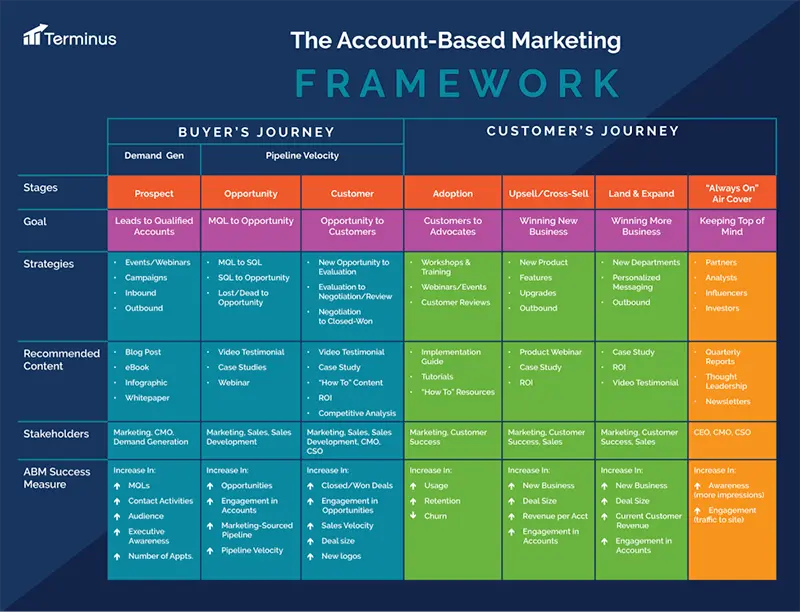
source: terminus
Stage 8: Observing the results
Just as with any other marketing strategy, it is important to analyze the data to see how your campaigns are performing. How to measure account-based marketing?
-
Track the conversion rate in each channel
Tracking your ABM efforts may seem daunting at first, but there are also a variety of tools to help you with the evaluation. For example, you can check out your website traffic in Google Analytics under the Behavior section. Social media sites like Instagram, Facebook, LinkedIn, etc. also have analytics tools that will provide you specific insights. If you need to track link visits from direct mail, create a Bitly link that you can place on offline campaigns.
-
Identify the best practices used
There is no sense in using a marketing tactic that never converts or gives you a return on your investment. Be sure to track the tactics that work best and the tactics that don’t work.
-
Improve according to accounts, not individuals
While you work with individuals mostly in ABM, don't forget that you should be versatile. If something is bad for one person, it's not necessarily bad for the account.
Which are the essential pros and cons you should pay attention to in ABM?
Like any other technologies, ABM has its pros and cons. Let’s start with the pros.
Pros
-
The personalized approach increases the conversion rate in most cases
Instead of relying on large-scale campaigns aimed at attracting a larger number of potential customers to you, ABM focuses only on the prospects that are most likely to buy and uses personalized campaigns to engage these prospects specifically. The better the personalization, the higher the conversion rates.
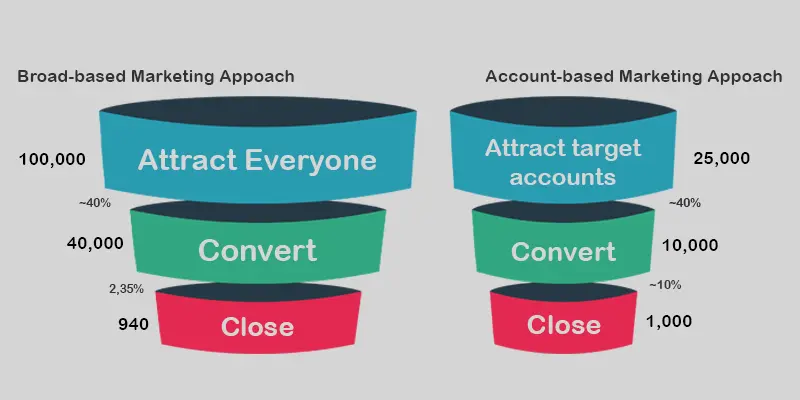
source: salesforce
-
Marketing and sales work together on a shared observable goal
According to SiriusDecisions, B2B companies where marketing and sales teams work together and focus on the same goals, grow revenue 19% faster.
-
Sales funnel is much shorter than for inbound marketing
Major purchasing decisions involve several interested parties. As a rule, this slows down the sales process because it starts at a lower level in the organization and slowly moves towards the main decision maker. In account-based marketing, the sales cycle length is shortened as all prospects are nurtured simultaneously.
-
The ROI is the highest and easiest to track
Almost 85% of marketers who measure ROI say that account-based marketing is delivering higher returns than any other marketing approach. Plus, with focusing on fewer accounts, it is simpler to analyze your customers’ engagement with your campaigns.
-
All the available resources are utilized wisely
Using a strategy based on collecting leads, companies spend a decent amount of $ to acquire as many leads as possible. However, with a lead-based strategy, it is impossible to avoid leads that are a poor fit. As a result, businesses spend a lot of money in vain. It is much more cost-effective to determine which accounts are the best fit for your products or services, and only then spend money to reach out to them using different channels where they are active (web, social networks, events, etc.)
Read our blog post: “Best Tips and Ways to Build the Right Sales Funnel for Your Business.”
Cons
How about the ABM’s cons?
-
It is hard to define the most valuable target accounts
A negative reality of account-based marketing is that sales and marketing use different stats and see clients differently.
-
The desired results might often be failed
This may lead to a total waste of money, as the targeted account may be poorly chosen and turn out to be unsatisfactory.
-
Differences in how to measure account-based marketing stats
Marketers use marketing automation tools, and sales use CRMs, which brings disorder.
The best working account-based marketing examples you can use
-
Live events
Live events are an excellent opportunity for sales teams to meet with decision-makers in person and get a chance to convince them. If you use an ABM approach to events, you can make personalized invitations of key customers from target accounts, organize special VIP dinners, give personalized gifts to target accounts, as well as provide personalized support after the event.
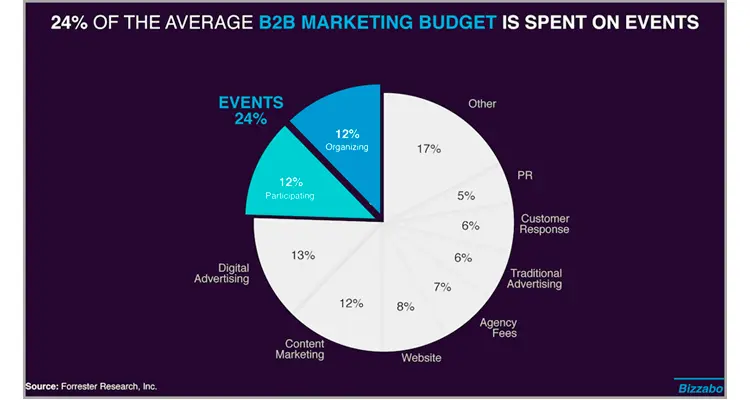
source: jeffbullas
-
Webinars and seminars
Seminars and webinars can be an extremely powerful tactic if executed correctly. Unique content should be created with the target audience in mind.
-
Personalized emails
Personalized emails belong to one of the easiest account-based marketing best practices but only when executed correctly. Let's suppose you have identified a group of ten contacts at one of your top accounts that could potentially become your customer. One account-based marketing tactic to consider would be to create a series of emails and personalize each one by role. Your emails should contain relevant, helpful content that addresses the challenges of each specific person. And remember, your goal is not to show how much you know about the contact personally but to provide helpful content focused on resolving known contact issues.
-
PPC ads for target accounts
PPC and paid social ads are a widely-used method to reach your target accounts. Social media platforms such as Facebook and LinkedIn will let you target specific companies and individuals.
-
Website personalization
Using website personalization to display relevant content and personalized messages to visitors that fall into specific criteria is also a wise idea.
Conclusion
In short, account-based marketing (ABM) is when marketing and sales teams work closely and focus all of their attention on accounts that matter. ABM’s popularity has been growing recently, and it’s easy to see why. When compared to traditional lead generation strategies, ABM is much more cost-effective, because first, you determine the accounts that fit your products or services, and only then spend money to reach out to them using different channels. ABM is often called “zero-waste marketing.”
To create your own account-based marketing plan, follow these eight essential steps:
- Step 1: Define the essential attributes of an ideal account
- Step 2: Find real individuals who correlate with chosen profiles the most
- Step 3: Create the definition of an optimal targeting campaign
- Step 4: Build your marketing campaigns
- Step 5: Identify the right channels to reach target accounts
- Step 6: Develop a plan of action
- Step 7: Execute the ABM campaign
- Step 8: Observe the results




